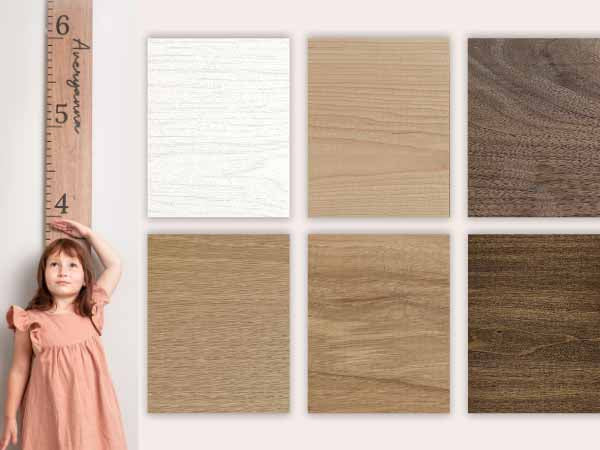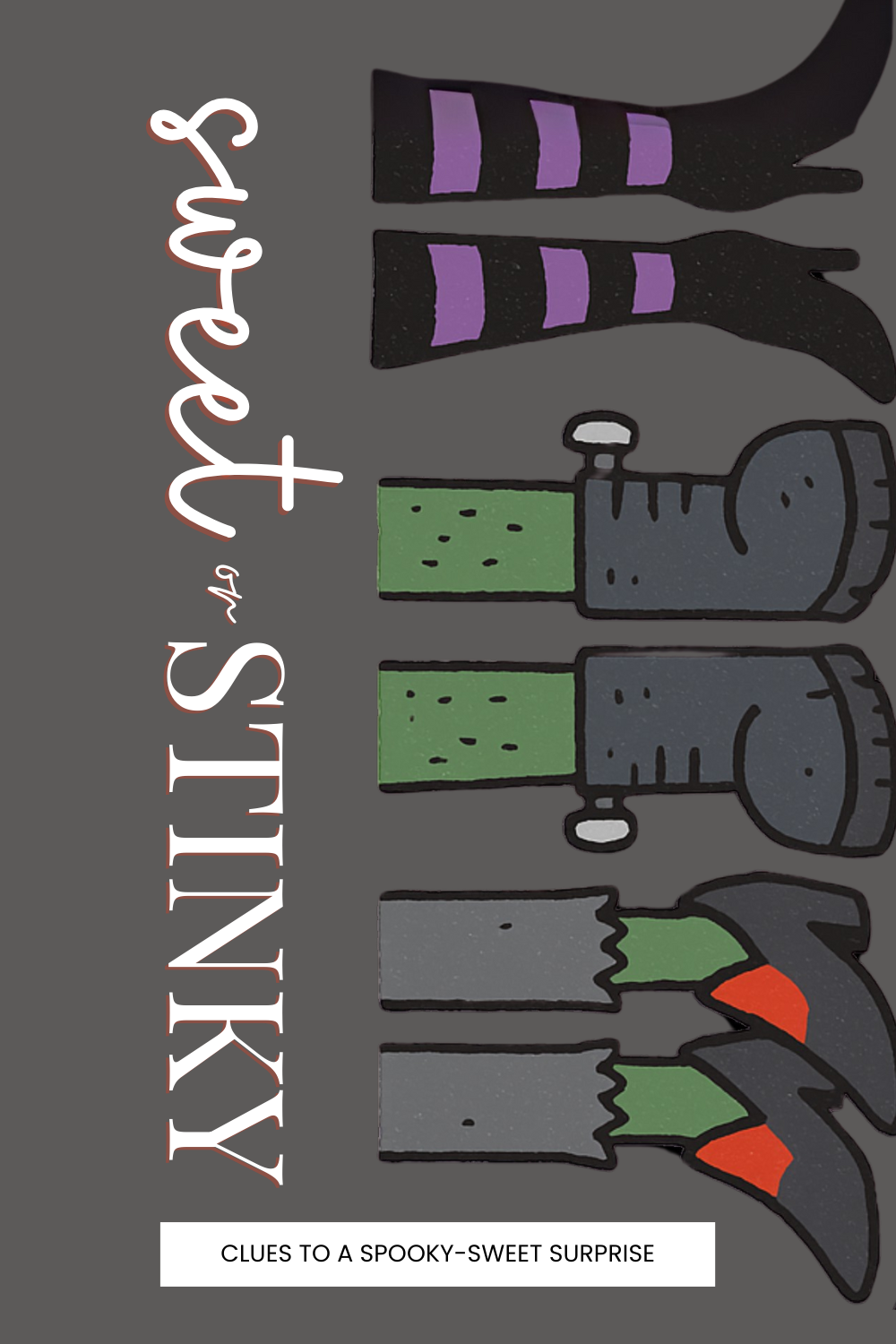Are you searching for the perfect handcrafted growth ruler that not only captures your child's growth but also adds a touch of natural beauty to your space? Look no further!
But, before you embark on this sentimental journey, let's talk about the heart and soul of these markers of time: the wood.
Join me as we explore different wood species of hardwoods – hickory, maple, white oak, walnut, and poplar. We'll deep dive into the characteristics of different wood species and help you make an informed decision when selecting your very own handcrafted growth ruler.

Hardwood Ruler Characteristics
Whether you're drawn to the warmth of oak, the elegance of walnut, or the charm of hickory, understanding the qualities of each wood species will allow you to choose the perfect growth ruler that truly reflects your style and complements your home decor.
Below we'll review tone, grain pattern, hardness, and more.
*Janka Hardness Scale: The higher the number, the more resistant the wood is to dents, dings, or scratches. Higher rated woods will stand the test of time, and the wear and tear that life with kids will surely throw at it.
White: Neutral Charmer
- Tone: Clean and neutral, bright
- Grain Pattern: Smooth surface with minimal grain visibility, offering a minimalist and elegant appearance
- Texture: Smooth and sleek, with a clean and polished surface
- Janka Hardness Scale: 1450 - 1820
- Mom-Talk: Clean, minimalist look and feel; satin paint can be used to cover unwanted marks (aka kid scribbles)
White-painted growth rulers seamlessly adapt to various home styles. The neutral tone of a white ruler allows it to effortlessly blend with your existing color scheme, creating a cohesive and visually appealing atmosphere. It's a timeless option that captures the essence of your child's growth while adding a touch of elegance to your living space.
Maple: Timeless Elegance
- Tone: Light to medium tones
- Grain Pattern: Smooth and even grain, with a fine and uniform appearance
- Texture: Smooth
- Known for: Warm and inviting tones and smooth grain
- Janka Hardness Scale: 1450
- Mom-Talk: Sophisticated, simple, pinker undertones compared to other options; unwanted marks can be sanded out
Opt for maple if you desire a timeless and elegant look, with its smooth and even grain. Picture the fine, uniform appearance of a maple growth ruler, suitable for homes with a classic or contemporary design. I recommend maple for its simplicity and sophistication, creating a canvas for your kiddos' growing memories.
White Oak: Versatility for Any Space

- Tone: Medium-brown color
- Grain Pattern: Distinctive grain patterns, featuring a combination of straight lines and occasional rays
- Texture: Medium grain texture, providing a tactile and visually interesting surface
- Known for: Versatile and classic appearance
- Janka Hardness Scale: 1360
- Mom-Talk: Classic look and feel, grayer or cooler undertones compared to other options; unwanted marks can be sanded out
Consider white oak for its versatility, adapting to various home styles effortlessly. Explore the distinctive grain patterns and warm, medium-brown color, suitable for transitional or traditional spaces. I suggest white oak growth rulers for homes with mixed styles, seamlessly blending into your everyday family life.
Hickory: Dynamic and Durable
- Tone: Varies from light to dark streaks, creating a dynamic feel
- Grain Pattern: Pronounced and contrasting grain, with bold streaks and variations showing movement
- Texture: Smooth to coarse, reflecting a robust nature
- Known for: Pronounced and contrasting grain patterns
- Janka Hardness Scale: 1820
- Mom-Talk: Our bestseller, warm undertones, striking, fits a wide range of color schemes; easy to clean or sand off unwanted marks, hard to dent
Consider hickory for its strength and durability, perfect for the wear and tear of daily family life. Appreciate the contrasting light and dark streaks in hickory's grain, providing a charming touch. I suggest placing a hickory growth ruler in a farmhouse or rustic-themed home, where its robust nature complements the family-friendly chaos.
Stained Poplar: Clean Slate

- Tone: Warm brown over a neutral base for a clean and simple appearance
- Grain Pattern: Neutral grain pattern, lacking distinctive characteristics of other hardwoods
- Texture: Smooth and fine texture, creating a clean and polished surface
- Janka Hardness Scale: 540
- Mom-Talk: Warm, rich color, consider adding our arrow markers for easier visibility of heights; unwanted marks are harder to clean off, but may blend in with the darker surface; more likely to show dings than other hardwoods
Introducing poplar, a wood species known for its versatility. While it may not have the distinctive characteristics of hickory, maple, or walnut, poplar's neutral grain and light color provide a clean slate for staining. Stained growth rulers can seamlessly integrate into various aesthetics, making it a practical choice for growing families.
Walnut: A Touch of Warmth and Luxury
- Tone: Rich, dark tones, adding warmth and a touch of luxury
- Grain Pattern: Straight and elegant grain, featuring fine lines and dark swirls
- Texture: Smooth and fine texture, offering a luxurious and refined feel
- Known for: Overall uniform and appealing grain
- Janka Hardness Scale: 1010
- Mom-Talk: Deep and moody tones, a statement piece; unwanted marks can be sanded out
Choose walnut for its rich, dark tones, adding a touch of warmth and luxury to your kids' space. The straight, elegant grain patterns of walnut, create a stylish yet practical growth ruler. I recommend walnut growth rulers for homes with a modern or contemporary style, reflecting a balance of sophistication and fun.
Choosing What Fits Best
Wood Characteristics:
Now, let's take a closer look at how these wood species stack up against each other.
- Grain Patterns: Each wood type brings a unique grain pattern to the table. Hickory showcases contrasting streaks, maple boasts a smooth and even grain, white oak features distinctive patterns, walnut presents straight and elegant lines, and poplar offers a neutral and clean slate.
- Color Palette: From the mix of light and dark tones in hickory to the warm medium-brown of white oak, the rich darkness of walnut, and the light elegance of maple, each wood species has a distinct color palette.
- Strength and Durability: Hickory stands out for its exceptional strength, making it an excellent choice for families with active children. If durability is a top priority, hickory might be your go-to.
- Versatility: White oak takes the lead in versatility, seamlessly blending into various home styles. If you anticipate changes in your home's aesthetic over time, white oak might be the adaptable choice you're looking for. Poplar also shines in versatility, providing a clean canvas for any design.
Home’s Style:
- For Rustic Charm: If you love a farmhouse or rustic aesthetic, hickory is the go-to choice with its strength and distinctive grain.
- Timeless Sophistication: Maple suits classic or contemporary designs, offering a timeless and sophisticated look for your growth ruler.
- Versatile Appeal: White oak's adaptability makes it a fantastic choice for homes with mixed styles or those that may change over time.
- Modern Elegance: Walnut, with its rich tones and elegant grain, is ideal for modern or mid-century modern homes seeking a touch of luxury.
More Considerations:
- Color Harmony: Take a moment to consider the color palette of your home. Does the wood tone harmonize with your existing furniture and decor? Whether it's the warm tones of hickory, the light elegance of maple, the versatile medium-brown of white oak, the rich darkness of walnut, or a neutral palette, choose a wood that enhances the overall color scheme.
- Lifestyle Compatibility: Consider the demands of your lifestyle and how well each wood species aligns with them. If you have active little ones running around, the durability of hickory might be a lifesaver. If your kids (or grandkids) are tamer than mine, the affordability and versatility of poplar could be a practical solution.
- Long-Term Vision: Think about the long-term vision for your home. Will your design preferences remain consistent, or do you anticipate changes? The timeless appeal of maple and the versatile nature of white oak lend themselves well to evolving styles, while hickory or walnut provide more unique characteristics to consider.
As you embark on the journey of choosing the right wood for your kids' growth ruler, let your home's style and your personal preferences guide you. Each wood species brings its own charm, and the perfect fit is the one that not only captures the growth of your little ones but also resonates with the heart and soul of your home.
Here's to creating a meaningful and stylish piece of heirloom-quality artwork in the place where your family's story unfolds. Happy measuring!









